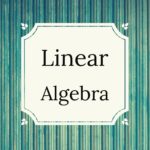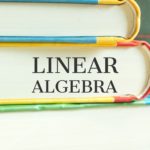Spanning Sets for $\R^2$ or its Subspaces

Problem 691
In this problem, we use the following vectors in $\R^2$.
\[\mathbf{a}=\begin{bmatrix}
1 \\
0
\end{bmatrix}, \mathbf{b}=\begin{bmatrix}
1 \\
1
\end{bmatrix}, \mathbf{c}=\begin{bmatrix}
2 \\
3
\end{bmatrix}, \mathbf{d}=\begin{bmatrix}
3 \\
2
\end{bmatrix}, \mathbf{e}=\begin{bmatrix}
0 \\
0
\end{bmatrix}, \mathbf{f}=\begin{bmatrix}
5 \\
6
\end{bmatrix}.\]
For each set $S$, determine whether $\Span(S)=\R^2$. If $\Span(S)\neq \R^2$, then give algebraic description for $\Span(S)$ and explain the geometric shape of $\Span(S)$.
(a) $S=\{\mathbf{a}, \mathbf{b}\}$
(b) $S=\{\mathbf{a}, \mathbf{c}\}$
(c) $S=\{\mathbf{c}, \mathbf{d}\}$
(d) $S=\{\mathbf{a}, \mathbf{f}\}$
(e) $S=\{\mathbf{e}, \mathbf{f}\}$
(f) $S=\{\mathbf{a}, \mathbf{b}, \mathbf{c}\}$
(g) $S=\{\mathbf{e}\}$
Sponsored Links
Contents
Solution.
By definition, the subspace $\Span(S)$ spanned by $S$ is the set of all linear combinations of vectors in $S$. Thus, $\Span(S)$ is a subset in $\R^2$. The question is whether all of the vectors in $\R^2$ are linear combinations of vectors in $S$ or not.
(a) $S=\{\mathbf{a}, \mathbf{b}\}$
Let $\begin{bmatrix}
a \\
b
\end{bmatrix}$ be an arbitrary vector in $\R^2$. We determine whether it is a linear combination of $\mathbf{a}$ and $\mathbf{b}$:
\[\begin{bmatrix}
a \\
b
\end{bmatrix}=c_1\mathbf{a}+c_2\mathbf{b}.\]
The augmented matrix is
\begin{align*}
\left[\begin{array}{rr|r}
1 & 1 & a \\
0 & 1 & b
\end{array} \right]
\xrightarrow{R_1-R_2}
\left[\begin{array}{rr|r}
1 & 0 & a-b \\
0 & 1 & b
\end{array} \right].
\end{align*}
Hence, the solution is $c_1=a-b$, $c_2=b$.
Thus, we have
\[\begin{bmatrix}
a \\
b
\end{bmatrix}=(a-b)\mathbf{a}+b\mathbf{b},\]
and this implies that every vector in $\R^2$ is a linear combination of $\mathbf{a}$ and $\mathbf{b}$.
Hence, $\Span(S)=\R^2$.
(b) $S=\{\mathbf{a}, \mathbf{c}\}$
Just like part (a), let $\begin{bmatrix}
a \\
b
\end{bmatrix}$ be any vector in $\R^2$.
Are there $c_1, c_2$ satisfying
\[\begin{bmatrix}
a \\
b
\end{bmatrix}=c_1\mathbf{a}+c_2\mathbf{c}?\]
The augmented matrix is
\begin{align*}
\left[\begin{array}{rr|r}
1 & 2 & a \\
0 & 3 & b
\end{array} \right]
\xrightarrow{\frac{1}{3} R_2}
\left[\begin{array}{rr|r}
1 & 2 & a \\
0 & 1 & b/3
\end{array} \right]
\xrightarrow{R_1-2R_2}
\left[\begin{array}{rr|r}
1 & 0 & a-\frac{2}{3}b \\
0 & 1 & b/3
\end{array} \right].
\end{align*}
Hence, we have $c_1=a-\frac{2}{3}b$, $c_2=b/3$.
Thus,
\[\begin{bmatrix}
a \\
b
\end{bmatrix}=\frac{2b}{3} \mathbf{a}+\frac{b}{3}\mathbf{c}.\]
This yields that every vector in $\R^2$ is in $\Span(S)$. Hence $\Span(S)=\R^2$.
(c) $S=\{\mathbf{c}, \mathbf{d}\}$
The strategy for this problem is the exactly same as before. So let us consider
\begin{align*}
\left[\begin{array}{rr|r}
2 & 3 & a \\
3 & 2 & b
\end{array} \right]
\xrightarrow{R_2-R_1}
\left[\begin{array}{rr|r}
2 & 3 & a \\
1 & -1 & b-a
\end{array} \right]
\xrightarrow{R_1\leftrightarrow R_2}
\left[\begin{array}{rr|r}
1 & -1 & b-a \\
2 & 3 & a
\end{array} \right]\\[6pt]
\xrightarrow{R_2- 2 R_1}
\left[\begin{array}{rr|r}
1 & -1 & b-a \\
0 & 5 & 3a-2b
\end{array} \right]
\xrightarrow{\frac{1}{5}R_2}
\left[\begin{array}{rr|r}
1 & -1 & b-a \\
0 & 1 & \frac{3}{5}a-\frac{2}{5}b
\end{array} \right] \\[6pt]
\xrightarrow{R_1+R_2}
\left[\begin{array}{rr|r}
1 & 0 & -\frac{2}{5}a+\frac{3}{5}b \\
0 & 1 & \frac{3}{5}a-\frac{2}{5}b
\end{array} \right].
\end{align*}
It follows that any vector $\begin{bmatrix}
a \\
b
\end{bmatrix}\in \R^2$ can be written as a linear combination
\[\begin{bmatrix}
a \\
b
\end{bmatrix}=\left(-\frac{2}{5}a+\frac{3}{5}b \right)\mathbf{c}+\left( \frac{3}{5}a-\frac{2}{5}b \right) \mathbf{d}.\]
Hence, $\Span(S)=\R^2$.
(d) $S=\{\mathbf{a}, \mathbf{f}\}$
This is also similar to previous problems. For any vector $\begin{bmatrix}
a \\
b
\end{bmatrix}\in \R^2$, we have
\begin{align*}
\left[\begin{array}{rr|r}
1 & 5 & a \\
0 & 6 & b
\end{array} \right]
\xrightarrow{\frac{1}{6}R_2}
\left[\begin{array}{rr|r}
1 & 5 & a \\
0 & 1 & b/6
\end{array} \right]
\xrightarrow{R_1-5R_2}
\left[\begin{array}{rr|r}
1 & 0 & a-\frac{5}{6}b \\
0 & 1 & b/6
\end{array} \right].
\end{align*}
This yields that
\[\begin{bmatrix}
a \\
b
\end{bmatrix}=\left(a-\frac{5b}{6} \right)\mathbf{a}+\left(\frac{b}{6}\right)\mathbf{f}.\]
Hence, $\Span(S)=\R^2$.
(e) $S=\{\mathbf{e}, \mathbf{f}\}$
Note that as the vector $\mathbf{e}$ is the zero vector, any linear combination of $\mathbf{e}$ and $\mathbf{f}$ is just a scalar multiple of $\mathbf{f}$:
\[c_1\mathbf{e}+c_2\mathbf{f}=c_2\mathbf{f}.\]
Thus, the algebraic description is
\begin{align*}
\Span(S)=\Span(\mathbf{e}, \mathbf{f})=\Span(\mathbf{f})=\{\mathbf{x}\in \R^2 \mid \mathbf{x}=c\mathbf{f} \text{ for some } c\in \R\}.
\end{align*}
Geometrically, the span is the line parametrized by $c\mathbf{f}=c\begin{bmatrix}
5 \\
6
\end{bmatrix}$ for any $c\in \R$.
(f) $S=\{\mathbf{a}, \mathbf{b}, \mathbf{c}\}$
Note that $\Span(\mathbf{a}, \mathbf{b})$ is contained in $\Span(\mathbf{a}, \mathbf{b}, \mathbf{c})$ because any linear combination of $\mathbf{a}$ and $\mathbf{b}$ is a linear combination of $\mathbf{a}, \mathbf{b}$, and $\mathbf{c}$ by taking the coefficient of $\mathbf{c}$ to be $0$.
We already saw in part (a) that $\Span(\mathbf{a}, \mathbf{b})=\R^2$. Hence, we must have $\Span(\mathbf{a}, \mathbf{b}, \mathbf{c})=\R^2$ as well.
(g) $S=\{\mathbf{e}\}$
Note that $\Span(\mathbf{e})$ is the set of all linear combination of $\mathbf{e}$, which is just the zero vector. So,
\[\Span(\mathbf{e})=\left\{\begin{bmatrix}
0 \\
0
\end{bmatrix}\right\}.\]Geometrically, this is just one point: the origin in the $x$-$y$ plane.
 Add to solve later
Add to solve later
Sponsored Links

















